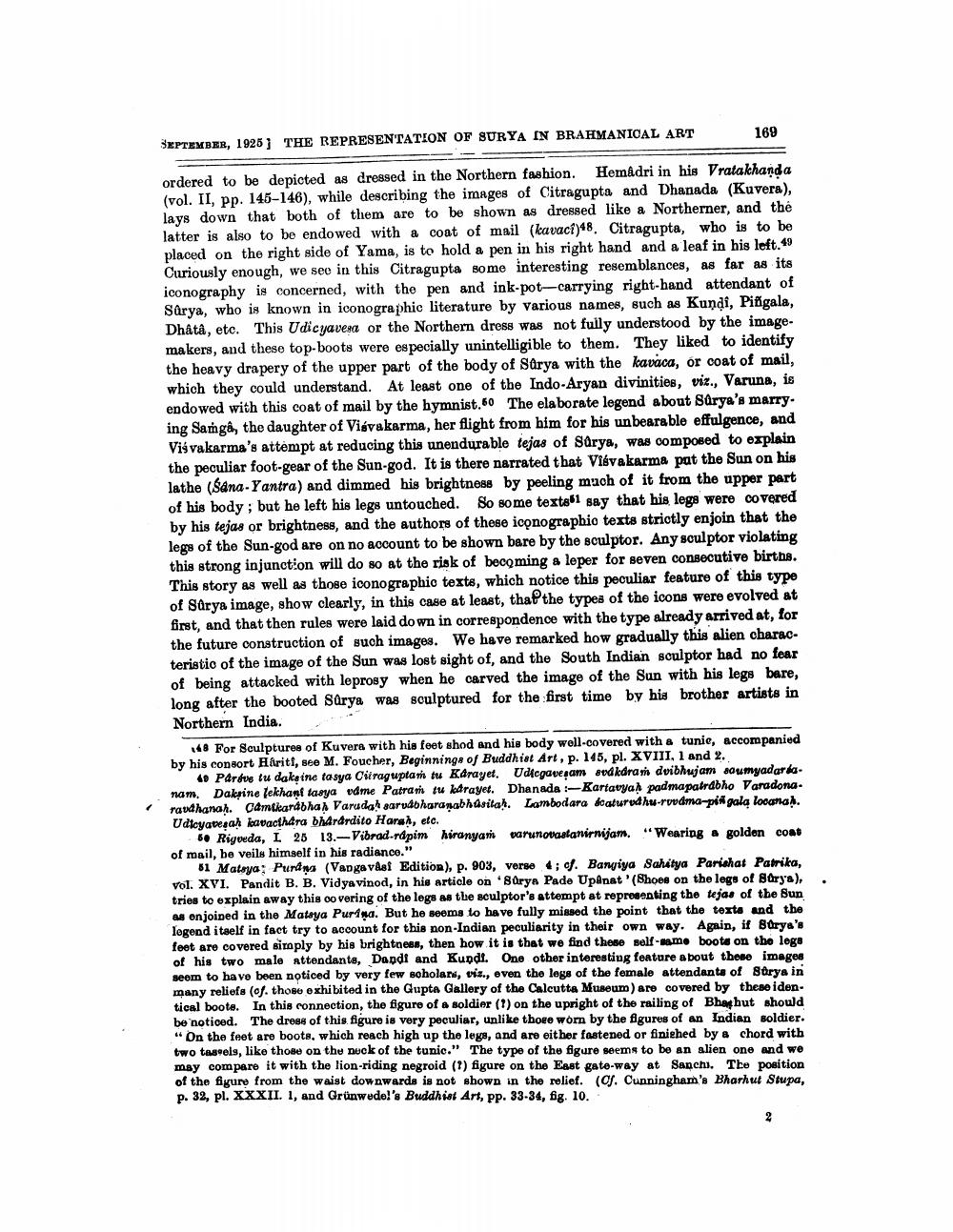________________
ŠEPTEMBER, 1925) THE REPRESENTATION OF SURYA IN BRAHMANICAL ART
169
ordered to be depicted as dressed in the Northern fashion. Hemadri in his Vratakhanda (vol. II, pp. 145-146), while describing the images of Citragupta and Dhanada (Kuvera), lays down that both of them are to be shown as dressed like a Northerner, and the latter is also to be endowed with a coat of mail (kavací)48. Citragupta, who is to be placed on the right side of Yama, is to hold a pen in his right hand and a leaf in his left.49 Curiously enough, we see in this Citragupta some interesting resemblances, as far as its iconography is concerned, with the pen and ink-pot-carrying right-hand attendant of Sarya, who is known in iconographic literature by various names, such as Kundi, Piñgala, Dhâtâ, etc. This Udicyavera or the Northern dress was not fully understood by the imagemakers, and these top-boots were especially unintelligible to them. They liked to identify the heavy drapery of the upper part of the body of Sürya with the kavaca, or coat of mail, which they could understand. At least one of the Indo-Aryan divinities, viz., Varuna, is endowed with this coat of mail by the hymnist.60 The elaborate legend about Sarya's marry. ing Samgå, the daughter of Vibvakarma, her flight from him for his unbearable effulgence, and Vigvakarma's attempt at reducing this unendurable tejas of Surya, was composed to explain the peculiar foot-gear of the Sun-god. It is there narrated that Vibvakarma pat the Sun on his lathe (Sana-Yantra) and dimmed his brightness by peeling much of it from the upper part of his body; but he left his legs untouched. So some texts61 say that his legs were covered by his tejas or brightness, and the authors of these iconographic texts strictly enjoin that the legs of the Sun-god are on no account to be shown bare by the sculptor. Any sculptor violating this strong injunction will do so at the risk of becoming a leper for seven consecutive births. This story as well as those iconographic texts, which notice this peouliar feature of this type of Sarya image, show clearly, in this case at least, thap the types of the icons were evolved at first, and that then rules were laid down in correspondence with the type already arrived at, for the future construction of such images. We have remarked how gradually this alien characteristic of the image of the Sun was lost sight of, and the South Indian sculptor had no fear of being attacked with leprosy when he carved the image of the Sun with his legs bare, long after the booted Sarya was sculptured for the first time by his brother artists in Northern India.
148 For Sculptures of Kuvera with his feet shod and his body well-covered with & tunie, accompanied by his consort Harit, see M. Foucher, Beginnings of Buddhist Art, p. 145, pl. XVIII, 1 and 2.
49 Pardue tu daksine tasya Ciiragupta tu Karayet. Udicgavepam svd kdram dvibhujam aqumyadaria. nam. Dakpine Lekhanf tasya udme Patram tu barayet. Dhanada - Kartavyah padmapatrabho Varadona. raudhanar. Camikanátha, Varudal sarudbharanabhúsitat. Lambodara saturudhu-roodma-pingala locana. Udtoyave ar kavacthara bhardrdito Hara, etc.
50 Rigveda, L 26 13.-Vibrad-rapim hiranyan varunovaslanirnijam. "Wearing golden coat of mail, be veils himself in his radiance."
51 Mataya: Pundma (Vangavast Edition), p. 903, verse 4; of. Bangiya Sahitya Parishat Patrika, vol. XVI. Pandit B. B. Vidya vinod, in his article on Arya Pada Upanat' (Shoes on the legs of try's), tries to explain away this covering of the legs as the sculptor's attempt at representing the tejas of the Sun w onjoined in the Matsya Purga. But he seems to have fully missed the point that the texto and the logend itself in fact try to account for this non-Indian peculiarity in their own way. Again, if Burya's feet are covered siraply by his brightness, then how it is that we find these self-samo boots on the logs of his two male attendante, Dapdi and Kundi. One other interesting feature about these images seem to have been noticed by very few soholar, viz., even the legs of the female attendants of Shrys in many reliefs (of. those exhibited in the Gupta Gallery of the Calcutta Museum) are covered by these identical boote. In this connection, the figure of a soldier (1) on the upright of the railing of Bhahut should be noticed. The dress of this figure is very peculiar, unlike those worn by the figures of an Indian soldier. "On the feet are boots, which reach high up the legs, and are either fastened or finished by & chord with two tassels, like those on the nuck of the tunic." The type of the figure seems to be an alien one and we may compare it with the lion-riding negroid (1) figure on the East gate-way at Sanchi. The position of the figure from the waist downwards is not shown in the relief. (cf. Cunningham's Bharhut Stupa, p. 32, pl. XXXII. 1, and Grünwede!'s Buddhist Art, pp. 33-34, fig. 10.




